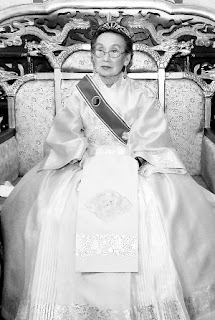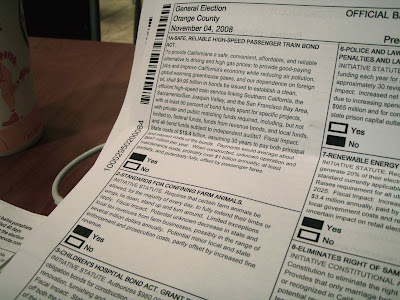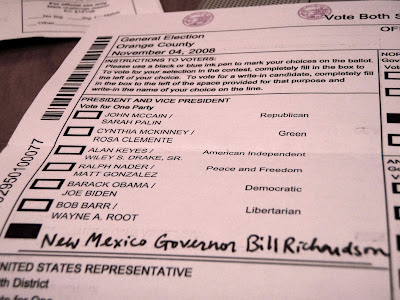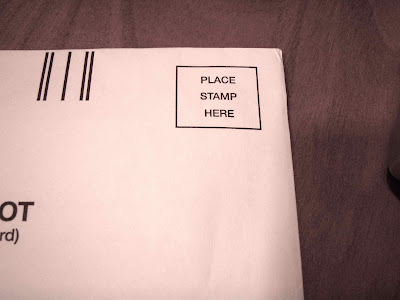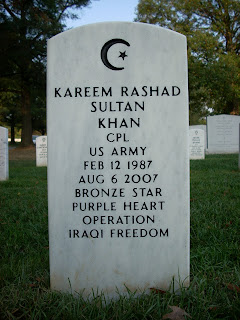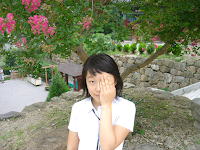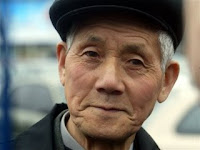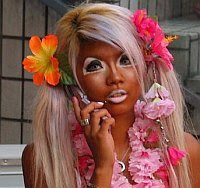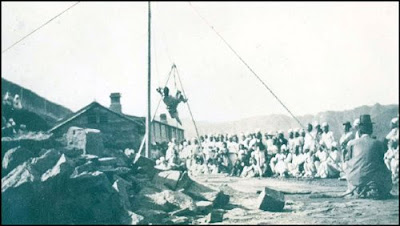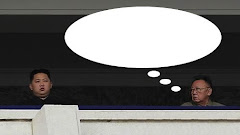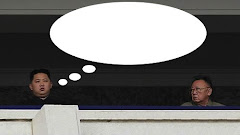 Cyber serendipity seems to rule my life, especially when I go to K-blogs such as Marmot's Hole and then find myself following a trail of bread crumbs from one topic to another. This time it was Robert Neff's comment about how South Korea's current president has a name, Lee Myungbak (i•myŏng•bak, 이명박, 李明博) has a name very similar to that of Emperor Kojong of Chosŏn Korea before he became the monarch, Lee Myŏngbok.(i•myŏng•bok, 이명복, 李命福).
Cyber serendipity seems to rule my life, especially when I go to K-blogs such as Marmot's Hole and then find myself following a trail of bread crumbs from one topic to another. This time it was Robert Neff's comment about how South Korea's current president has a name, Lee Myungbak (i•myŏng•bak, 이명박, 李明博) has a name very similar to that of Emperor Kojong of Chosŏn Korea before he became the monarch, Lee Myŏngbok.(i•myŏng•bok, 이명복, 李命福).
That was something I did not know, though I might not have thought about it too much because, like many Koreans, the different Chinese characters (明 and 命, even though they're both myŏng, and 博 and 福, respectively bak and bok, which have the same consonants but different vowels) would have obscured the similar sounds.
Anyway, I verified Mr Neff's statement at Wikipedia (the research tool for lazy people) and then proceeded to follow a bunch of different links at the Emperor Kojong entry. Part of the entry lists his children, some of whom married Japanese and obtained Japanese citizenship themselves after liberation in 1945. The guy had sex with a lot of concubines (which I know from doing translations of Korean documentaries was sanctioned for Korean monarchs).
Among his children was Yi Ch'ŏk (李坧), who for three years was Korea's last emperor (imperial name Sunjong, 純宗) before Japan forcibly annexed Korea in 1910. From that time, however (according to Wikipedia), Sunjong was a "pretender to the throne of the Korean Empire."
So even though the Yi-headed Chosŏn Dynasty was officially deposed in 1910 by the absorption of Korea by Japan, the Imperial House of Yi (李氏, Isshi) lays claim to the throne.
Now I was aware that there were those who carried on the imperial line despite their commoner status. I even discussed one of them (Yi Sŏk), in 2006. What I didn't know was how formalized they were and that there were now three contested imperial monarchs.
I don't know why, but on clicking the link to Yi Haewon I was expecting to find someone else in their forties, but she was born in 1919, making her eighty-nine years old. That woman has seen a lot of history on the peninsula: her birth year was when the Samil Undong (March 1st movement) had Koreans in the street protesting Japanese rule; when she was in her twenties liberation came and then in her thirties the Korean War broke out. Since then she has seen Korea rise from the ashes to the regional powerhouse that it is.
Apparently other members of the Korean Imperial Family Association have decided that she, as second daughter of Prince Imperial Ŭi (aka Yi Kang), who was fifth son of Emperor Kojong and his concubine, Lady Sudŏktang, should be crowned empress.
The first I read about was Yi Won (이원, 李源), the 46-year-old general manager of Hyundai Home Shopping network. Next I clicked on Yi Haewon (이해원, 李海瑗), the second main contestant (a third, Yi Chung, is the closest direct male heir to Emperor Kojong who has retained Korean citizenship, but he has no interest in the throne).
By the way, her father really got around. From 1909 to 1953 (a forty-four year period) he fathered twelve sons and nine daughters through his wife and fourteen concubines. And this is mostly after the imperial family had been deposed!
Upon the death in 2005 of her nephew Yi Ku (이구) who had since 1970 been the official pretender to the Korean throne (his father Yi Ŭn, a former general in the Japanese Imperial Army Air Forces, had held the title from 1926 when his half brother the aforementioned Emperor Sunjong died), she was picked by twelve members of the Korean Imperial Household to take the throne. In September 2006 she was declared yŏhwang, or empress, at which time she declared the restoration of the Korean throne.
If you are still paying attention to all this, my hat is off to you. I find this kind of history and intrigue fascinating, especially when there are squabbles over who is a rightful successor. It's even more interesting when you add in the Japanese element: many members of the Korean imperial family ended up marrying Japanese royalty or nobility, often under pressure by the Japanese side that wanted to blend the two houses as a way of solidifying the new connection between the two countries. After liberation and the Korean War, some of these ethnic Japanese members of the Korean imperial household obtained Korean citizenship and lived in a traditional Korean palace until their deaths in the 1980s.
But the "foreign" element was not always Japanese. The wife of Yi Ku, the pretender to the throne from 1970 to 2005, was one Julia Mullock, an American of Ukrainian descent. Both were working for the I.M. Pei architectural firm in the late 1950s shortly after Yi Ku graduated from MIT.
Divorced from the Prince Imperial in 1982 (due to pressure from the Imperial Family since she had not produced an heir), the former Imperial Highness Princess Julia (Mullock) Lee is still alive at the age of eighty, reportedly living in an apartment in southern Seoul's upscale Kangnam-gu Ward. Universal Studios was interested in making a movie about her life.
Ms Mullock-Lee (?) is not the only Caucasian to be so close to a high-profile figure in Korea. The Republic of Korea's first president, Syngman Rhee (이승만, yi•sŭng•man) was married to an Austrian, Franziska Donner, whom he had met in Geneva in 1933 when he was trying to prevent occupied Korea's case to the League of Nations.
"Francesca" (as she was known by those in Korea who revered her) served as First Lady of Korea from 1948 to 1960 when her husband was forced into exile. They stayed in Honolulu, in a home only about a mile as a crow flies from where I now live. I jogged by there one day; it's a humble, non-descript place you wouldn't realize was the home of an ex-president. She returned to Korea and died there in 1992.
Sphere: Related Content

